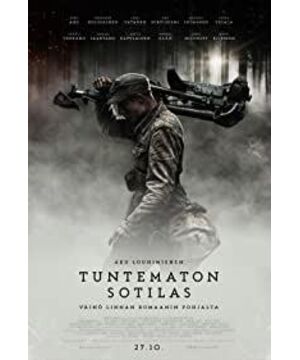To understand "The Unknown Soldier", we must first understand a little about the historical entanglement between the former Soviet Union and Finland. Historically, Finland was originally the territory of Sweden, the hegemony of Northern Europe. After Sweden was defeated by the newly rising Russian Empire in the Northern War, it was forced to cede Finland to Russia. Russia established the Grand Duchy of Finland in the Finnish region, with the Tsar self-governing the Grand Duchy and implementing semi-local autonomy under the Tsar's rule. In 1917, the October Revolution broke out, Tsarist Russia fell apart, and Finland took the opportunity to become independent. In the following 20 years, there has been a great dispute between the Soviet Union and Finland on the division of the border. The focus of the conflict between the two sides is the ownership of the Karelian Isthmus. The Karelian Isthmus is a narrow road channel between Lake Ladoga and the Gulf of Finland in Russia. The south is Leningrad in the former Soviet Union, the old Tsarist Russia and St. Petersburg in the Russian Federation now. Its strategic location is extremely important. When Finland gained its independence in 1917, most of the isthmus was in its pocket, and its border was close to Leningrad, posing a great threat to the former Soviet Union's second-largest city and even the northwestern part of the Soviet Union. In order to expand the strategic depth, the former Soviet Union has negotiated with Finland since the 1920s, wanting Finland to cede 40 kilometers of land and several islands, but all of them were rejected by Finland. In the late 1930s, with the rise of Nazi Germany and the closer relations between Finland and Germany, the desire of the former Soviet Union to obtain the Karelian Isthmus became stronger and stronger, and finally launched the Winter War in 1939, attempting to seize the isthmus and even occupy the entire Finland. . However, in this war, the Finnish army showed extremely strong combat effectiveness, which not only did not allow the Soviet army to destroy Finland, but also caused a large number of casualties to the Soviet army. It is said that Hitler saw the tragic situation of the Soviet army in the Winter War, and finally formulated the Barbarossa plan to destroy the Soviet Union. But the difference between modern warfare and ancient warfare is that modern warfare is about the overall national strength, and cleverness and ingenuity can only be won for a while, but not for a lifetime. Although Finland caused a large number of casualties to the Soviet Union, it was also forced to sit at the negotiating table and signed the "Moscow Peace Agreement" in March 1940, ceding the Karelian Isthmus and its surrounding territories to the Soviet Union. After this humiliation, Finland will naturally hate it. So Finland and Nazi Germany hit it off, and in 1941 cooperated with Germany's Barbarossa plan to launch a war against the Soviet Union, known in history as "continued war". The purpose of the Finnish government is to retake the Karelian Isthmus and expand its territory to establish the Great Finnish State. The war started off smoothly, and while the former Soviet army was busy dealing with the Nazi attack, the Finnish army quickly conquered lost territory and occupied a lot of Soviet territory. But the Finnish offensive was quickly stopped, and both sides Enter the confrontation stage. Su Fen seems to have returned to the era of World War I and fought trench warfare. By the summer of 1944, the Soviet army had completely established its superiority in the war against Germany and could free up its hands to clean up Finland. In just over a month, the Soviet army completed the counterattack and drove the Finnish army back to the border established by the two countries in 1940. Shortly thereafter, Finland made peace with the Soviet Union, not only recognizing the validity of the 1940 Moscow Peace Agreement, but also ceding more territory to the Soviet Union. Judging from the results of the war, Finland paid a huge price throughout the continuing war. Not only did it fail to avenge its grievances, but it also took in a lot of lives and lost a large area of territory. Probably because the war was too tragic, Finland became a neutral country after the war and served as a bridge between East and West during the Cold War. After understanding the above history, it is not difficult to find that the theme of the film "The Unknown Soldier" has nothing to do with patriotic passion. Its real theme is only one - anti-war. No matter how eloquent the politicians are, it is not them who really shed blood on the battlefield, but the soldiers who rolled in the mud and charged with bullets. Therefore, whether or not to go to war, it is the soldiers who are on the front line of war who really have the right to speak. The film focuses on a grass-roots company of the Finnish Army, showing the soldiers' real view of the war through them. At the beginning of the war, the soldiers may still have a little passion to reclaim their homeland. They crossed the new frontier established in 1940 and marched towards the "old frontier" before the outbreak of the Winter War in 1939. In their opinion, the war should be over as long as the land lost in the previous war is recaptured. So they said all the way: "I'll go home in XXX." But they never thought that Finland could have the initiative to start a war, but not necessarily have the right to end it. This war was unexpectedly long, and the soldiers' patriotic passion became more and more numb in the bloodshed and sacrificed day after day, but the desire to return home became more and more intense. The veteran played by Eno Aho has experienced the Winter War and has a particularly thorough understanding of the truth of the war. War is killing, and all other so-called noble names are nothing. He ignored the discipline of the army, the orders of his superiors, and just wanted to live well on the battlefield and bring his friends home alive. The other young soldiers didn't understand this at first, but the war slowly made them understand it. Therefore, at the end of the war, in order to return home, they could disobey the orders of their superiors, abandon positions that could not be held, throw away their cumbersome machine guns, and desperately retreat to the "old frontier". The "Old Frontier" at this time is no longer the "Old Frontier" before the 1939 Winter War
View more about Tuntematon sotilas reviews











